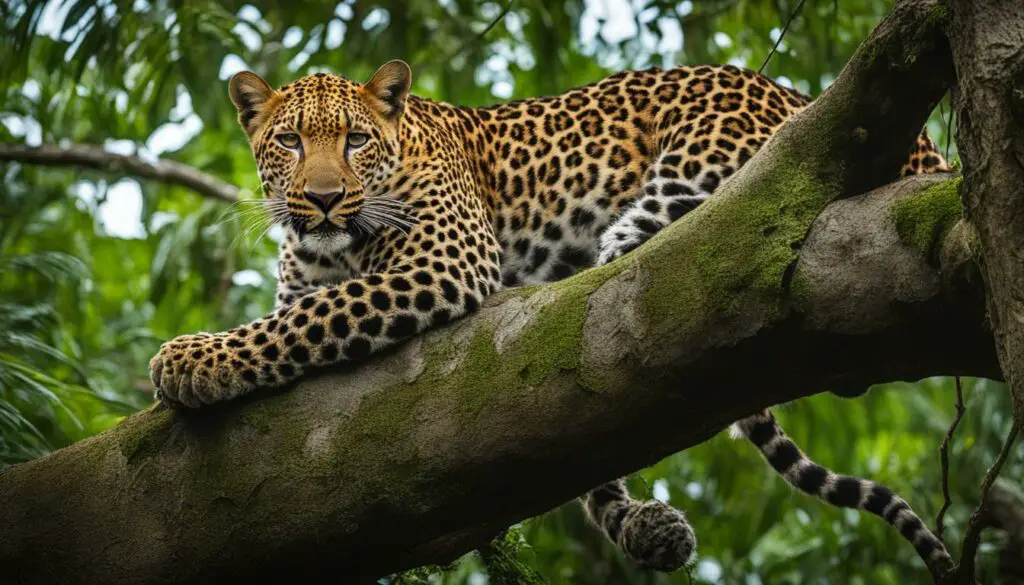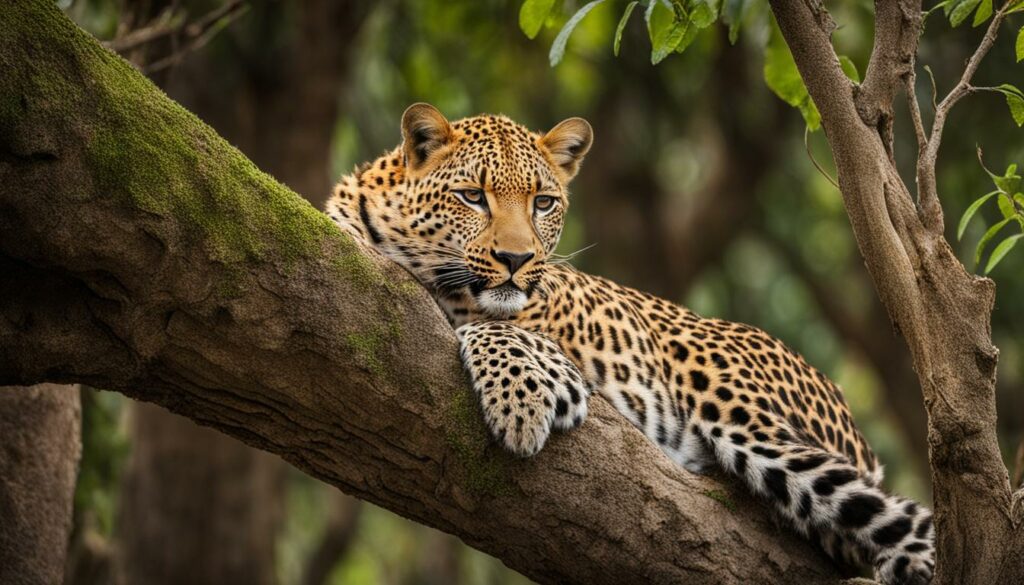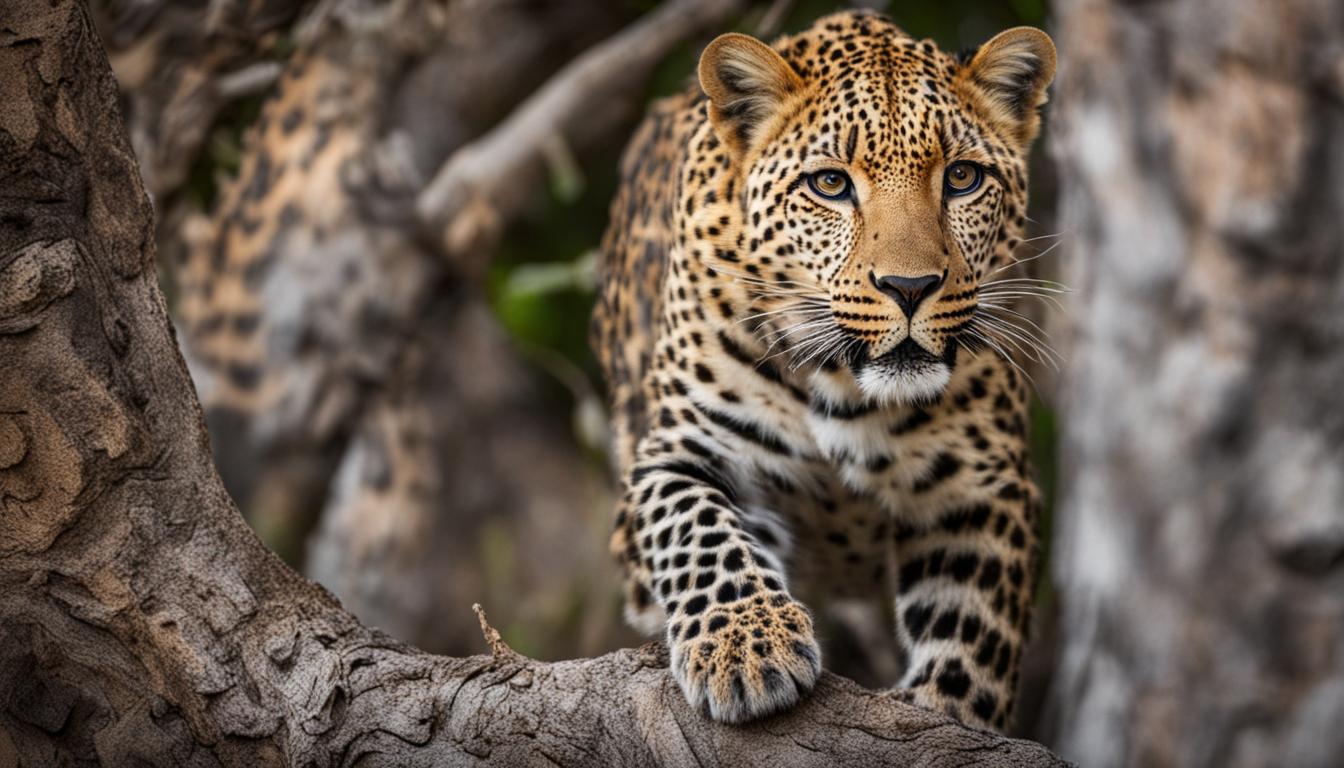Leopards are fascinating creatures that have developed remarkable adaptations to survive in diverse habitats. From their physical attributes to their behavioral patterns, these big cats have evolved unique strategies for thriving in their surroundings. Let’s explore the different adaptations that make leopards such successful predators.
When it comes to leopard adaptations, their physical attributes play a crucial role. Their muscular, sleek, and fast bodies, coupled with sharp teeth and claws, make them powerful hunters. These physical adaptations allow them to effectively capture and attack their prey, ensuring a constant food supply.
But leopards’ adaptations go beyond their physical capabilities. Their behavioral adaptations also contribute to their survival. These solitary animals are primarily nocturnal, maximizing their hunting abilities while minimizing competition with other predators. This unique behavior enhances their chances of successful hunting and ultimately ensures their survival.
By understanding leopard adaptations, we can gain a deeper appreciation for these magnificent creatures and the role they play in maintaining ecosystem balance. In the following sections, we will delve into specific aspects of leopard adaptations, including their diet, habitat, evolutionary and ecological roles, and their ability to adapt to human presence. Let’s dive in and learn more about these incredible big cats!
Leopard Diet: Adaptations
Leopards have developed remarkable adaptations in their diet that allow them to thrive in various environments. Unlike other predators that rely on specific food sources, leopards display a flexible feeding behavior and can consume a diverse array of animals. Their diet includes large antelope, birds, fish, fruit, and even small mammals like mice. This adaptability ensures that leopards always have access to food, even when certain prey populations become scarce or difficult to find.
The ability to consume a wide range of food sources is a crucial adaptation for leopards, as it provides them with a higher chance of survival in their habitats. When faced with the scarcity of one type of prey, leopards can easily switch to another food source, allowing them to maintain a balanced diet and meet their nutritional needs.
This dietary adaptability also plays a role in the conservation of leopards. By diversifying their diet, these big cats contribute to the stability of their ecosystems. They help control the population of certain prey species, preventing overgrazing and maintaining a healthy balance within the food chain.
Table: Comparison of Leopard Food Sources
| Food Sources | Description |
|---|---|
| Large Antelope | Leopards are skilled hunters and can take down antelope species such as impalas and gazelles. |
| Birds | Leopards have the agility to climb trees and hunt birds both on the ground and in the air. |
| Fish | Leopards are adept swimmers and can catch fish from rivers, lakes, and other water bodies. |
| Fruit | Although not their primary food source, leopards consume fruits when available, providing additional nutrients. |
| Small Mammals | Leopards feed on small mammals such as mice, rats, and hares, which are abundant in their habitats. |
With their adaptable diet, leopards have developed a remarkable ability to survive and thrive in diverse environments, ensuring their continued existence as magnificent predators.
Leopard Habitat: Adaptations
Leopards have evolved remarkable adaptations that allow them to thrive in their diverse habitats. These adaptations are primarily focused on their hunting abilities, ensuring their success as efficient predators.
One of the key adaptations of leopards is their muscular and agile bodies, perfectly suited for their habitat. With their strong limbs and stocky build, leopards excel at climbing trees. This adaptation not only helps them escape from potential threats but also offers them a strategic advantage in hunting. Leopards often drag their kills up into trees, protecting their prey from scavengers and other predators. This behavior helps ensure a steady food supply and allows them to eat in peace.
Another vital adaptation is their exceptional camouflage. Leopards have a unique coat pattern consisting of rosette-shaped spots that help them blend into their surroundings. This enables them to effectively hide from both prey and predators, giving them the element of surprise during their stealthy approach. By remaining undetected, leopards increase their chances of hunting success.
To further enhance their hunting prowess, leopards possess sharp teeth and retractable claws. These formidable weapons allow them to deliver a swift and fatal bite to the neck of their prey, ensuring a quick and efficient kill. Their retractable claws also help maintain their sharpness, as they can be retracted when not in use.
With these remarkable adaptations, leopards have established themselves as apex predators in various habitats across the globe. Their ability to blend into their environment, climb trees, and deliver precise attacks has made them highly successful hunters, ensuring their survival in their respective habitats.
Leopard Behavioral Adaptations
Leopards have developed behavioral adaptations that contribute to their survival in their respective environments. One of the key behavioral strategies employed by leopards is their primarily nocturnal behavior. By being active at night, leopards are able to avoid competition with other predators and increase their chances of successful hunting. This adaptation allows them to take advantage of the cover of darkness and surprise their prey.
In addition to being nocturnal, leopards are also solitary animals. They typically live alone in a specified territory, which helps them avoid conflicts with other leopards and ensures they have enough resources to survive. This behavior allows them to maintain access to food sources and minimize competition, ultimately contributing to their overall survival.
Another notable behavioral adaptation of leopards is their ability to adapt their hunting techniques based on the availability of prey. Leopards are opportunistic hunters, meaning they are adaptable in their prey selection. They can target a wide range of animals, including primates, gazelles, antelopes, pigs, and birds. This flexibility in their hunting behavior increases their chances of finding food and surviving in changing environments.
The Nocturnal Behavior of Leopards
The nocturnal behavior of leopards is a key adaptation that allows them to thrive in their habitats. Being active at night provides them with several advantages. Firstly, it helps them avoid competition with other predators such as lions and hyenas, which are more active during the day. Secondly, the cover of darkness allows leopards to blend in with their surroundings and make use of their stealth and agility to surprise their prey. By relying on their exceptional night vision and acute hearing, leopards are able to navigate and hunt effectively in the dark.
This nocturnal behavior also enables leopards to conserve energy during the hot daytime hours. They are able to rest and seek shelter during the day, avoiding exposure to extreme temperatures and reducing the risk of dehydration. By conserving energy and staying hidden during daylight hours, leopards are able to maintain their survival and increase their chances of successfully hunting prey at night.
Overall, the behavioral adaptations of leopards, including their nocturnal behavior and solitary nature, are crucial to their survival in their respective habitats. These adaptations allow them to efficiently hunt for food, avoid conflicts with other leopards, and adapt their hunting strategies based on the availability of prey. By understanding and appreciating these behavioral adaptations, we can develop a deeper appreciation for the incredible resilience and adaptability of these magnificent big cats.

Leopard Evolutionary and Ecological Adaptations
Leopards have undergone significant evolutionary adaptations that have enabled them to thrive in their specific environments. One notable adaptation is their coat color and pattern, which helps them blend seamlessly into their surroundings, providing camouflage during hunting and protection from predators. The leopard’s spotted coat allows them to move stealthily through a variety of landscapes, whether it be the dense forests of Africa or the rocky terrain of the mountains.
Another evolutionary adaptation of leopards is their exceptional agility and climbing ability. Their muscular, stocky legs enable them to navigate trees effortlessly, allowing them to stash their kills out of reach from potential scavengers and compete effectively with other predators for food resources. This adaptation also helps them establish territorial dominance and protect their young from potential threats.
The leopard’s evolutionary adaptations have equipped it with the tools necessary for survival and success in its respective habitats.
In terms of their ecological role, leopards play a vital role as top predators. They help regulate prey populations, ensuring the balance and sustainability of ecosystems. By controlling herbivore numbers, leopards prevent overgrazing and subsequent habitat degradation. Their presence also influences the distribution and behavior of other species within their ecosystems, contributing to the overall health and biodiversity of the environment. The ecological role of leopards illustrates the interconnectedness of species and the importance of maintaining balanced predator-prey relationships.
In conclusion, leopards have evolved remarkable adaptations that allow them to thrive in their diverse habitats. Their coat color and pattern provide essential camouflage, while their agility and climbing abilities enable them to navigate a range of landscapes. Additionally, as top predators, leopards play a crucial ecological role in maintaining the balance of their ecosystems. Understanding and appreciating these evolutionary and ecological adaptations is essential for the conservation and preservation of these magnificent big cats.
Table: Leopard Evolutionary and Ecological Adaptations
| Adaptation | Description |
|---|---|
| Coat color and pattern | Camouflage and protection |
| Agility and climbing ability | Effective hunting and territorial dominance |
| Top predator role | Regulating prey populations and maintaining ecosystem balance |
Leopard Survival Adaptations
Leopards have developed a range of survival adaptations that enable them to thrive in the face of challenges, including human presence and habitat loss. These adaptations have allowed leopards to become more adaptable and resilient in their search for new territories and resources.
One key adaptation is their ability to live in a variety of habitats and eat a diverse range of food. This flexibility ensures that leopards can find enough food to survive, even when their preferred prey is scarce. By being adaptable in their diet, leopards can increase their chances of survival in changing environments.
Another survival adaptation is their ability to adapt to human presence. Leopards have shown a remarkable ability to coexist with humans, even in areas with high levels of human activity. They have learned to navigate urban environments and find alternative food sources, such as domestic animals. This adaptation allows leopards to survive in fragmented habitats and continue to play their important ecological role as top predators.
Leopards have evolved to be highly adaptable and resilient in the face of human impacts and changing environments. Their survival adaptations, including their flexible diet and ability to coexist with humans, enable them to continue thriving in the wild.

The Role of Conservation Efforts
Conservation efforts play a crucial role in supporting the survival adaptations of leopards. By protecting their habitats and creating wildlife corridors, conservationists can help leopards access new territories and resources. Additionally, initiatives that raise awareness about the importance of leopard conservation can help reduce conflicts between humans and leopards, ensuring the long-term survival of these magnificent big cats.
- Create protected areas and wildlife corridors to maintain a connected habitat for leopards.
- Implement measures to reduce human-wildlife conflicts, such as promoting responsible tourism practices and providing alternative livelihoods for communities living near leopard habitats.
- Conduct research and monitoring to better understand leopard populations and their adaptations to changing environments.
- Engage local communities in conservation efforts through education and capacity-building programs.
By implementing these conservation strategies, we can support the survival of leopards and protect their important ecological role in maintaining a healthy and balanced ecosystem.
| Threats to Leopard Survival | Conservation Strategies |
|---|---|
| Habitat loss and fragmentation | Create protected areas and wildlife corridors |
| Human-wildlife conflicts | Reduce conflicts through responsible tourism, alternative livelihoods, and community engagement |
| Poaching and illegal wildlife trade | Enforce laws and regulations, enhance anti-poaching efforts |
Leopard Predator Adaptations
Leopards are formidable predators, equipped with a range of adaptations that make them highly efficient hunters. Their powerful bodies, sharp teeth, and retractable claws enable them to swiftly take down their prey. With muscular and sleek physiques, combined with their exceptional agility, leopards can maneuver effortlessly through their environments, making them formidable and stealthy predators.
One key adaptation of leopards is their keen sense of sight, which allows them to spot potential prey from a distance. Their eyesight is finely tuned, enabling them to see clearly in low light conditions, making them well-suited for their nocturnal hunting habits. Additionally, their acute hearing helps them detect even the slightest sounds, allowing them to locate their prey with precision.
Leopards are opportunistic hunters and have a diverse diet. This adaptability allows them to select their prey according to availability and abundance. While they commonly hunt smaller mammals like gazelles, antelopes, and pigs, they are also known to target larger prey such as primates and birds when the opportunity presents itself. This flexibility in prey selection ensures their survival, even in environments where resources may be scarce.
| Leopard Prey Selection | Prey Types |
|---|---|
| 1. | Small mammals |
| 2. | Large antelope |
| 3. | Primates |
| 4. | Birds |
| 5. | Fish |
| 6. | Fruit |
| 7. | Mice |
Leopards are adaptable predators that have successfully coexisted with other species due to their ability to adjust their hunting techniques and choose from a wide range of prey. This flexibility, paired with their physical and sensory adaptations, positions leopards as apex predators in their habitats, playing a vital role in maintaining the delicate balance of ecosystems.
Conclusion
Leopards have evolved a range of adaptations that have enabled them to thrive in various environments. Their adaptations in diet, body structure, behavior, and hunting techniques contribute to their survival as top predators. Despite the challenges they face from human activities, leopards have shown resilience and adaptability, allowing them to continue to play an important ecological role in maintaining ecosystem balance.
Understanding these adaptations can help us appreciate and protect these magnificent big cats. Leopards have developed a diverse diet, enabling them to find food even in scarce conditions. Their muscular bodies, sharp teeth, and claws make them efficient hunters, capable of ambushing their prey.
Furthermore, leopards’ nocturnal behavior and solitary nature help them avoid competition and conflicts with other leopards. These behavioral adaptations, along with their physical characteristics, such as their coat color and pattern, contribute to their survival in their respective habitats.
Despite the threats they face, leopards have shown incredible resilience. Their ability to adapt to different conditions and habitats increases their chances of survival, even in the face of changing environments and human impacts. As top predators, leopards play a crucial role in controlling prey populations and maintaining a healthy balance in the ecosystem. It is vital that we continue to study and protect these remarkable creatures to ensure their long-term survival and the preservation of our planet’s biodiversity.
How do the spots on a leopard help them adapt to their environment?
Leopards spots purpose explained: The spots on a leopard’s fur allow them to blend seamlessly into their surroundings, making them almost invisible to their prey. This camouflage helps them to stalk and ambush their targets without being detected. Additionally, the spots also help regulate body temperature by absorbing and reflecting sunlight.
FAQ
How have leopards adapted to their environments?
Leopards have developed a variety of adaptations, including their diet, body structure, and behavior, to help them live in different types of habitats.
What is the diet of leopards and how does it help them adapt to their habitats?
Leopards have a diverse diet and can eat a variety of animals, ensuring they always have enough food to eat, even when certain food sources become scarce or hard to find.
How have leopards adapted their bodies to their habitats?
Leopards have strong and fast bodies with sharp teeth and claws that allow them to capture and attack their prey effectively. Their muscular legs also make them skilled climbers, enabling them to protect their kills from other predators.
What behavioral adaptations do leopards have?
Leopards are primarily nocturnal, meaning they are active at night, which helps them avoid competition with other predators and increases their chances of successful hunting. They are also solitary animals, usually living alone in a specified territory, to avoid conflicts with other leopards.
How have leopards evolved over time?
Leopards have developed physical characteristics, such as their coat color and pattern, to blend in with their surroundings and improve their chances of successfully hunting prey and avoiding predators. They are also important top predators in their habitats, helping control prey populations and maintain a healthy ecosystem balance.
How do leopards adapt to survive in the face of threats?
Leopards have become more adaptable to different conditions, allowing them to find new territories and habitats. Their ability to live in a range of habitats and eat different types of food increases their chances of survival even when faced with changing environments and human impacts.
How do leopards hunt and what is their prey selection?
Leopards are highly skilled hunters that stalk and ambush their prey. They have powerful bodies, sharp teeth, and claws that allow them to capture and kill a wide range of animals, including primates, gazelles, antelopes, pigs, and birds.
What is the conclusion regarding leopard adaptations?
Leopards have a range of adaptations that enable them to thrive in various environments. Their adaptations in diet, body structure, behavior, and hunting techniques contribute to their survival as top predators. Despite the challenges they face, leopards have shown resilience and adaptability, allowing them to continue playing an important ecological role in maintaining ecosystem balance.











